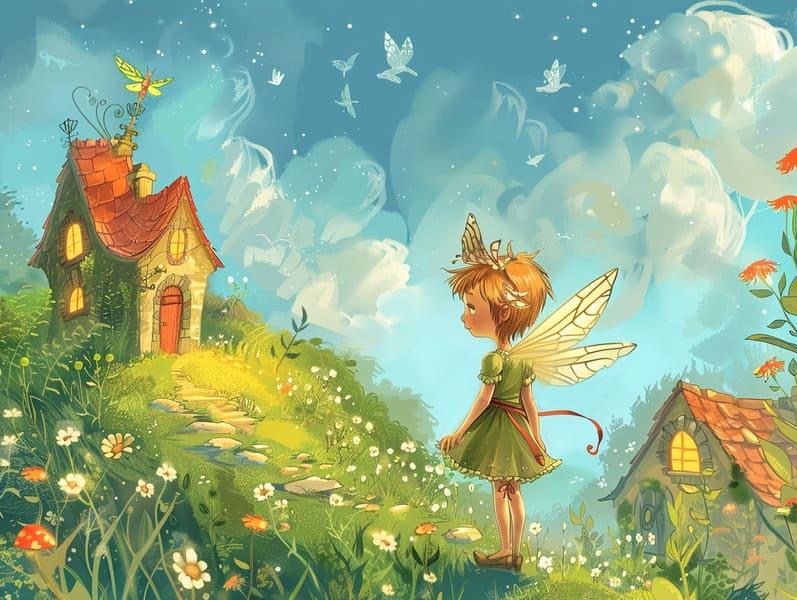
Short fairy tales have legendary status. These stories have been transmitted from one generation to the next well before they were ever recorded. They developed from a variety of backgrounds, including American traditions. They were initially disseminated among adults, often carrying themes and messages aligned with the societal norms and beliefs of the time.
Jacob and Wilhelm Grimm, the two Grimm brothers, were among the first to collect and release many of these beloved tales. Their collection, "Grimm's Folk Tales," included stories like "Cinder Maid," "The Bread Crumb Trail," and "Little Snow White," which have since become classics in the world of timeless fairy tales. Similarly, the Danish author's whimsical stories, such as "The Mermaid's Tale," and "The Duckling's Story," have enchanted hearts worldwide, establishing their place in the pantheon of treasured fairy tales.
Despite their historical roots, traditional fairy tales remain as impactful as ever, especially as nighttime stories for kids. These delightful tales are now available in many formats, including artistically illustrated books, delightful animations, and digital storybooks.
Their persistent charm can be attributed to several charming aspects:
Moral Lessons: Old fairy tales often teach important moral lessons. Stories like "The Tale of the Boy Who Cried Wolf" teach the importance of truth, while "The Hare and the Tortoise" exemplify the traits of steadfastness and humbleness. These narratives offer the young clear distinctions between good and bad, shaping their moral compass in a tender yet meaningful way.
Kindness and Comprehension: Traditional fairy tales frequently involve characters facing trials and tribulations, provoking listeners to feel with their struggles and root for their triumphs. For instance, "Beauty and the Beast" reveals the value of looking past the exterior to recognize the inner being of a being, enhancing sympathy and knowledge.
Cultural Perception: Many classic fairy tales are rich in the cultural contexts from which they originated. Delving into these stories can provide intriguing perspectives into different beliefs, enhancing a sense of world appreciation and understanding.
Inventiveness and Fantasy: The imaginative elements in ancient fairy tales—magical spells—inspire children’s fantastical thinking. These stories lead readers to supernatural realms, motivating creative ideas and a sense of marvel that endures a lifetime.
Old fairy tales are not only entrancing but also informative. They act as whimsical tools in promoting various thinking and feeling skills in little ones. When fairy tales are voiced, they develop language acquisition by teaching new phrases and complex sentence structures. This practice also nurtures listening abilities and focus, as young readers focus on every detail, eager to see what happens next.
Furthermore, talking about the themes and characters of fairy tales can cultivate problem-solving abilities and reasoning skills. The young are educated to identify patterns, foresee events, and grasp cause and effect. These contemplations also benefit little ones say their thoughts and feelings, adding to their emotional intelligence.
In today’s digital age, the prevalence of free fairy tales online has made these stories more attainable than ever. Digital sites and mobile apps offer wide arrays of classic fairy tales that can be experienced or heard anytime, anywhere. Fairy tales read aloud are particularly well-liked, making available an delightful method for kids to be a part of these mesmerizing stories. Audio stories and read-to-me stories transport characters and settings to life, often complemented by magical background sounds and musical scores that elevate the tale journey.
The timeless charm of traditional fairy tales lies in their ability to modify to present days while holding onto their main lessons. Contemporary renditions of these fairy tales often incorporate more representative characters and modern settings, making them understandable to today’s audience. However, the website fundamental themes of bravery, goodness, and lawfulness remain unchanged, continuing to impact young readers of all ages.
Timeless fairy tales also offer a sense of ease and recognition. They showcase a orderly narrative with a straightforward beginning, middle, and end, often concluding with the conclusion of conflicts and the triumph of rightness over wrongness. This regularity can be soothing for young ones, affording a sense of steadfastness in an inconstant world.
Ancient fairy tales continue to mesmerize and teach new generations, maintaining their captivation and value in modern society. As children's night stories, they bring a perfect blend of enchantment and education, developing moral values, empathy, and creativity. The proliferation of online storybooks and the likability of fairy tales told out loud warrant that these classic fairy tales remain obtainable to new generations.
By protecting and telling these narratives, we continue to exalt the rich tapestry of fantasy and cultural heritage. Whether you are perusing a gorgeously illustrated book, viewing a digital collection, or playing an read-aloud book, the charm of children's fairy tales is always within reach. These fairy tales teach us of the endless power of narratives and its ability to bond us across eras and regions.
No matter if you are browsing a gorgeously illustrated book, enjoying a virtual collection, or hearing an spoken story, the magic of classic fairy tales is always within reach.
These stories illustrate of the eternal essence of fairy tales and its ability to connect us across centuries and lands, casting a charm that captivates and teaches alike.